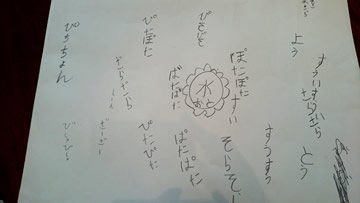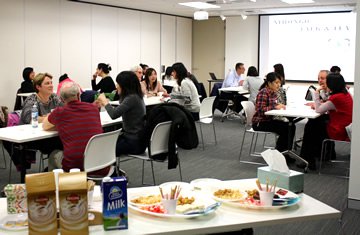Learning Japanese Opens a Whole New World
The Japan Foundation, Sydney
HACHISUKA Makiko, SUMA Ayuko, MITSUYA Mayumi
This article will introduce the teaching materials created and Japanese-language courses carried out by The Japan Foundation, Sydney (hereinafter the “Center”) as part of its overall operations.
Enriching Student Learning
The Center produces original teaching materials for classroom activities via the Classroom Resources section of our website to support as many Japanese-language teachers as possible throughout the vast country of Australia. The materials are oriented towards primary and secondary school, which comprises 97% of Japanese-language education in Australia. They are designed to be flexible so that teachers can apply them to their own students with a minimum of adjustments irrespective of the textbook being used. The range of primary and secondary education in Australia is wide, covering preparatory school, the equivalent of the third year of Kindergarten in Japan, up to grade 12, the equivalent of the third year of high school in Japan, and materials and activities are required that are appropriate to the developmental level of the children at each step of Japanese-language classes. Fun and familiar activities are needed for primary school, while deeper content, covering such topics as problems faced by society, is required for upper primary and secondary school. We keep the developmental level in mind as we create the teaching materials to prevent them from being too hard or too easy.
Primary school teaching materials are particularly difficult to create. The release of the Australia Curriculum in 2015 reflected an awareness of a need to provide students with the skills, knowledge, and abilities to survive in a globalized society and to contribute to the wellbeing of individuals and society, and this awareness included Japanese-language classes as well. However, the actual teaching topics covered are limited, such as colors, foods, vehicles, or animals, so we were working to figure out how we could expand our activities to meet the goals through trial and error.
At one point, however, the idea of one primary school teacher gave us a hint towards an answer. Specifically, it was a classroom activity based on the poem Oto (Sound) by Naoko Kudo. The poem contains numerous onomatopoeic words related to certain things, and the activity consists of having the children interact with those things and coming up with their own onomatopoeic words based on the sounds of those things. Examples of the words they came up with include “Sora” and “Piro.” What do you think those sound represented? The answer is actually water. Have you ever heard water making sounds like that? This is an activity made possible when the children have a strong ability to express themselves freely, and I felt it was an approach that could help stimulate the children‘s imagination and creativity as they learned Japanese. While the range of words that can be used may be limited, those words still have the ability to grow the children‘s abilities in a manner appropriate to their level of development.
Children who learn Japanese at the primary and secondary level do not all necessarily intend to learn to speak Japanese. This makes Japanese class but one part of the path towards the ultimate growth of each student. The teaching materials we created can therefore assist in their growth in addition to teaching Japanese. I think that is what is appealing about Japanese-language education at the primary and secondary level. My intent is to continue to create teaching materials that help enrich the children's education.

Results of the children‘s unrestricted imagination
Connecting People through Japanese Classes
I have been told that when the Center began offering Japanese courses, they were more like Japanese conversation salons geared towards intermediate to advanced-level Japanese learners. That start grew to encompass 18 classes covering beginner to senior advanced Japanese serving approximately 200 students. For 2017, we used Marugoto: Japanese Language and Culture (hereinafter “Marugoto”), a teaching material based on the JF Standard for all applicable classes. Meanwhile, the advanced and senior advanced classes that Marugoto does not cover use Can-Do for goal setting and performance evaluations to design classes based on the JF Standard.
While most of the students are adults, the represent a wide range of age groups, and many are senior citizens enjoying Japanese studies as a hobby after retirement. It is heartwarming to see two people who are far enough apart in age to be grandfather and grandchild to support each other in their language studies. Each class also features people from numerous cultural backgrounds, with abundant age groups and nationalities represented in the Sydney classes.
Sydney is home to numerous Japanese restaurants and Japanese brand shops where the locals can shop on a daily basis. Japan is also a popular destination and is frequently covered on local TV shows. Despite this familiarity with Japan, it still requires courage to approach a Japanese person on the street and say, “I’m studying Japanese. Would you converse with me?” Accordingly, we began holding the Nihongo Talk & Tea event series last year. The event allows students and Japanese people to talk freely while enjoying tea and rice crackers. In order to benefit the Japanese people who attend, we specifically contacted students of Japanese-language teacher training courses in the hope that it would serve as an opportunity for the students to get used to the Japanese used by Japanese-language learners.
The learners are able to experience having their Japanese understood at the Nihongo Talk & Tea event after studying the Marugoto materials. The satisfaction of communicating through Japanese, even when their Japanese ability is limited, can be seen up close in the smiles of the participants as they head home or invite each other to grab a bowl of ramen together.

Nihongo Talk &Tea
Nearly three quarters of all current learners are studying at the beginner to elementary level, presenting a very different cross section of students to the one that existed when the Japanese-language courses were first started. As we head towards the Tokyo Olympics, the popularity of learning Japanese is sure to grow. I hope to continue to make the Japanese-language courses exciting and a place always full of smiles where people can connect with each other.
- What We Do Top
- Arts and Cultural Exchange [Culture]
- Japanese-Language Education Overseas [Language]
- Japanese-Language Education Overseas [Language] Top
- Learn Japanese-language
- Teach Japanese-language
- Take Japanese-Language Test
- Know about Japanese-language education abroad
- The Japanese-Language Institute, Urawa
- The Japanese-Language Institute, Kansai
- Japanese-Language Programs for Foreign Specified Skilled Worker Candidates
- Japanese Language Education for Japanese Children Resident Overseas and for the Descendants of Migrants
- Archives
- Japanese Studies and Global Partnerships [Dialogue]
- JF digital collection
- Other Programs / Programs to Commemorate Exchange Year
- Awards and Prizes
- Publications
